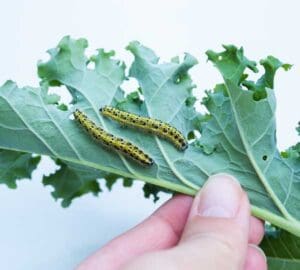Caterpillars, the larvae of moths and butterflies, can wreak havoc on your garden. Some species munch on leaves, while others eat the inside of fruit. In this guide, you’ll discover natural and organic techniques to tackle the leaf-eating species, as they are the easiest to manage.
Types of Leaf-Eating Moths & Butterflies
The most common pests that eat leaves include:
- Cabbage white butterfly
- Cluster caterpillar
- Cabbage moth
- Grapevine moth
- Loopers
- Light brown apple moth
- Lawn armyworm.
Leaf-munchers, including Cabbage white butterflies and Cluster caterpillars, typically lay eggs beneath leaves. Look for the tell-tale signs of chewed leaves and dark green droppings and inspect along leaf veins or undersides for hidden caterpillars.
Assess the Damage
 Before creating a plan for controlling these pests, ask yourself: Is the damage significant enough to warrant action? Sometimes, minor leaf loss might be a small payoff to get the benefits of certain insects in your garden, like the harmless Large Citrus butterfly.
Before creating a plan for controlling these pests, ask yourself: Is the damage significant enough to warrant action? Sometimes, minor leaf loss might be a small payoff to get the benefits of certain insects in your garden, like the harmless Large Citrus butterfly.
Physical Strategies
Handpicking caterpillars is effective, especially for minor infestations. Start a garden diary to keep track of the plants that are most vulnerable to attack. Consider adjusting planting times or changing the varieties you grow to deter pests. Using a butterfly net is an effective way to catch these critters.
Target Cabbage White Butterfly
The Cabbage White Butterfly is a notorious pest that targets Brassica (broccoli, cabbage, cauliflower, Asian greens) plants. This species does much damage early in the season as young plants have their growth set back by losing so much leaf area.
Methods for controlling this species include:
Decoys: Cabbage White Butterfly has a territorial behaviour pattern. A theory says if other Cabbage White Butterflies are present, a butterfly will leave the area looking for less populated plants to lay their eggs on. Setting up decoys can help. The simplest decoy is to scatter large pieces of eggshell amongst the cabbages and broccoli. The colour and shape of the eggshells can look like Cabbage White Butterflies. You can make your decoys out of white plastic or paper.
 Exclusion and Netting: Use butterfly nets or screens to prevent moths from laying eggs on plants.
Exclusion and Netting: Use butterfly nets or screens to prevent moths from laying eggs on plants.
Companion Planting: Dill, nasturtium, or mustard can be grown as trap crops to divert butterflies from laying eggs on more valuable crops. Upland Cress is an effective trap crop for several common pests, including moths and butterflies. Upland Cress leaves contain high levels of saponins and glucosinolates that attract the moths. The moths then lay their eggs on the leaves, but when the caterpillars hatch, the larvae take a bite of the leaves and die.
Living Mulch: Living mulches confuse the adult moths and butterflies and make it difficult for them to find the crop. Examples of this include using white clover underneath broccoli and cabbage crops. Living mulch works in several ways, partly by masking the smell of the crop and partly by changing the appearance of the crop, especially the light levels.
Repellent Plants: Pungent-smelling herbs have been used traditionally in both the garden and the home to keep moths at bay. Use hardy herbs such as wormwood, sage, lavender, and rosemary, suitable as a hedge around the vegetable garden.
Biological Control Methods
Promote natural predators like birds and insects by creating suitable habitats and offering nesting spaces. Insects such as lacewings, ladybirds, and wasps are crucial in controlling caterpillar populations.
Least-Toxic Chemical Solutions
Consider using Bacillus thuringiensis (Bt), found in Dipel, a safe bacterial stomach poison specifically targeting caterpillars. Apply it to foliage so that caterpillars consume it for adequate control.
Quick Tips for Caterpillar Control
1. If a caterpillar has chewed the leaves of your plants, then cut these bits off the leaves. The veggie is still edible. You can remove caterpillars by hand, which reduces the number of adults capable of laying eggs.
2. Catch moths with a butterfly net. It may take some practice, but it is an easy way to protect your plants.
3. Scatter broken eggshells near your cabbage plants. The colour of the eggshells confuses the Cabbage white butterfly, as it mistakes the shells for other butterflies. The butterflies will often try to seek another spot to lay their eggs.
4. Attract beneficial bugs and natural predators to your garden by growing diverse plants, including flowers and herbs.
5. Protect your plants from caterpillars by using mesh netting.
By combining these organic methods, you can effectively manage caterpillars in your garden while maintaining a thriving and chemical-free environment for your plants.


You are correct! I grew broccoli and cauliflower one year and purchased some plastic butterflies, on wooden skewers from a craft shop, which I spray painted white. As the plants grew I moved the skewers so they were always visible near the top of the plant. There was not one grub on my veggies at all. The cabbage butterflies happily flew over my garden and never landed once.